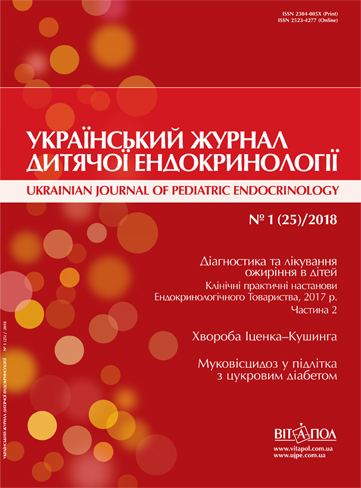Оптимізація дози соматотропного гормона під час лікування дітей допубертатного віку із синдромом біологічно неактивного гормона росту
Ключові слова:
синдром біологічно неактивного гормона росту, діти, соматотропний гормон, проба на чутливість до гормона росту, лікуванняАнотація
Мета робота — дослідити ефективність і безпечність застосування різних дозових рівнів рекомбінантного гормона росту (рГР) під час лікування дітей допубертатного віку із синдромом біологічно неактивного гормона росту (CБНГР) для поліпшення їхнього кінцевого зросту.
Матеріали та методи. Обстежено 93 дитини допубертатного віку від 3 до 10 років, які страждали від СБНГР. В усіх дітей констатовано відставання в рості понад 2 стандартних відхилень (SD) від фізіологічних показників. Для диференційної діагностики СБНГР та визначення чутливості до рГР використовували чотириденну пробу з гормоном росту. Лікування рГР всіх пацієнтів починали з дози 0,03 мг/кг/добу. Контрольну групу утворили 48 дітей допубертатного віку з гіпофізарним нанізмом.
Результати та обговорення. В основній групі відзначали менший ростовий ефект, ніж у контрольній. Статистично значуща різниця між ростовою прибавкою в основній і контрольній групах визначалася, починаючи з 6-го місяця лікування рГР, і залишалася до кінця 12-го місяця в разі застосування гормона. У дітей з незадовільною ростовою прибавкою дозу рГР збільшували до 0,035 мг/кг/добу, у разі подальшої недостатньої швидкості росту дозу рГР збільшували до 0,05 мг/кг/добу. Через 12 місяців лікування різними дозами рГР оптимальний ростовий ефект отримали в підгрупі дітей з дозою рГР 0,05 мк/кг/добу.
Висновки. Оптимально починати лікування хворих із СБНГР з дози рГР 0,035 мг/кг/добу, у разі незадовільного ефекту через 3—6 місяців дозу рГР рекомендовано підвищити до 0,05 мг/кг/добу.
Посилання
Dedov II, Tyul’pakov AN, Peterkova VA. Somatotropic insufficiency (in Rus). Moskva: IndexPrint, 1998:302.
Peterkova VA, Fofanova OV, Tyul’pakov AN, Semicheva TV, Kasatkina EP, Samsonova LN et al. National consensus. Diagnosis and treatment of somatotropic insufficiency in children (in Rus). M: ASK Yunion. Pechatnyye raboty, 2005:5.
Sprynchuk NA, Samson OYa. Clinical and diagnostic features and treatment of syndrome of biologically inactive growth hormone (in Ukr). Klіnіchna endokrinolohіya ta endokrynna khrurhya (Ukr). 2010;3(32):58-61.
Fofanova OV. Clinical polymorphism and molecular-genetic heterogeneity of somatotropic insufficiency in children: Avtoref dis d-ra med nauk (in Rus). M, 2000:41.
Bozzola E, Lauriola S, Messina MF, Bona G, Tinelli C, Tato L. Effect of different growth hormone dosages on the growth velocity in children born small for gestational age. Horm Res. 2004;62(3):141-2.
Gent J, Van Den Eijnden M, Van Kerkhof P. Dimerization and signal transduction of the growth hormone receptor. Mol Endocinol. 2003 May; 17(5):967-75.
Juul A, Bang P, Hertel NT. Serum insulin-like growth factor-I in 1030 healthy children, adolescents, and adults: relation to age, sex, stage of puberty, testicular size, and body mass index. J Clin Endocrinоl Мetab. 1994;78(3):744-52.
Kowarski AA, Schneider J, Ben-Galim E. Growth failure with normals erum RIA-GH and low somatomedin activity: somatomedin restoration and growth acceleration after exogenous GH. J Clin Endocrinol Metab. 1978;47(1978):461-4.
Layman L. C. Human gene mutations causing infertility. J Med Genet. 2002 Mar; 39(3):153-61.
Petkovic V, Thevis M, Lochmatter D, Besson A, Eblé A, Flück ChE et al. GH mutant (R77C) in a pedigree presenting with the delay of growth and pubertal development: structural analysis of the mutant and evaluation of the biological activity. Eur J Endocrinol. 2007;157: 67-74.
Ranke MB. Diagnosis of growth hormone deficiency and growth hormone stimulation tests. Ranke MB, Mullis P-E (eds): Diagnostics of Endocrine Function in Children and Adolescents, ed. 4. Basel, Karger, 2011:102-37.
Shevah O, Borrelli P, Rubinshtein M, Laron Z. Identification of two novel mutations in the human growth hormone receptor gene. J Endocrinol Invest. 2003;26(7):604-8.
Takahashi Y, Kaji H, Goji K, Okimura Y, Abe H, Chihara K. Short stature caused by a mutant growth hormone with an antagonistic effect. Endocr J. 1996 Oct;43:27-32.
Takahashi K, Kaji H, Okimura Y, Goji K, Abe H, Chihara K. Brief report: short stature caused by a mutant growth hormone. N Engl J Med. 1996 Feb 15;334(7):432-6.
Tanaka T. Global situation of growth hormone treatment in growth hormone-deficient children. Horm Res. 1999;51(3):75-80.
Tanner JM, Davies PS. Clinical longitudinal standards for height and height velocity for North American children. J Pediatr. 1985 Sep;107(3):317-29.





